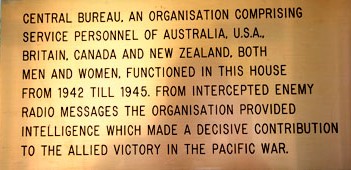
When Brisbane became the headquarters of General Douglas MacArthur’s South West Pacific Area (SWPA) in 1942, it developed into one of the key Allied centres in the Pacific War. The United States, Australia and the Netherlands East Indies formed the principal military and administrative presence in the city.
New Zealand, operating mainly under the separate South Pacific Area (SPA) command, did not deploy forces to Brisbane and played no direct operational role in the city. Its link with Brisbane was limited but still relevant within the broader context of Allied intelligence cooperation.
Two points are supported by available evidence: the presence of a New Zealand liaison representative within Central Bureau, and the occasional sharing of New Zealand-derived radio-intercept information into the wider Allied system that also supported Brisbane-based intelligence work.
A New Zealand liaison presence within Central Bureau
Central Bureau, headquartered at Nyrambla in Ascot, was the main signals intelligence organisation in MacArthur’s command. It brought together a range of Allied specialists, primarily from Australia, the United States, the UK and Canada.
Australian government summaries note that New Zealand was represented within Central Bureau through a liaison person rather than a team or dedicated unit. This individual served as a point of contact, ensuring that New Zealand’s signals intelligence activities could be aligned with broader Allied intelligence requirements when necessary.
The role was small in scale but consistent with the multinational nature of Central Bureau, which included liaison and specialist contributions from a number of Allied partners.
New Zealand intercept material within the wider Allied intelligence network
New Zealand operated several radio-intercept and direction-finding stations before and during the Pacific War. These facilities monitored Japanese radio transmissions and, at times, submarine activity. Much of this work was carried out by New Zealand naval intelligence personnel, including members of the Women’s Royal New Zealand Naval Service.
Intercepts collected in New Zealand were first processed in Wellington and then entered the wider British and American intelligence system. This larger network supported multiple Allied organisations across the Pacific, including those based in Australia.
Some historical analyses suggest that certain New Zealand-derived material may have been available to Central Bureau via this broader Allied exchange, though the specific pathways and frequency are not fully documented.
In this sense, New Zealand’s contribution should be understood as part of the general pool of Allied intelligence from which Brisbane-based analysts sometimes drew, rather than as a direct, continuous or structural supply line to Brisbane.
A careful understanding of the New Zealand–Brisbane link
New Zealand’s wartime connection with Brisbane was therefore modest. It did not involve operational command alignment, troop deployment or a sizeable intelligence contingent in the city.
Instead, the connection rested on:
• a single New Zealand liaison representative embedded within Central Bureau
• the indirect contribution of New Zealand intercept material through the wider Allied intelligence system
These links illustrate that while New Zealand was not a major participant in Brisbane’s wartime operations, it nonetheless formed part of the broader Allied intelligence environment from which Brisbane benefited.
Key sources
These sources support this measured interpretation:
• Australian Signals Directorate – summarising Central Bureau’s multinational composition, including New Zealand through liaison representation
• National Museum of Australia – overview of Central Bureau’s structure and contributing nationalities
• Royal New Zealand Navy Museum – documentation of WRNZNS radio-intercept work
• Nicky Hager, The Origins of Signals Intelligence in New Zealand – describing how New Zealand intercept material entered the wider Allied system
• Desmond Ball, Cliff Lord and Meredith Thatcher, Invaluable Service: The Secret History of New Zealand’s Signals Intelligence during Two World Wars – context for New Zealand’s SIGINT activity
